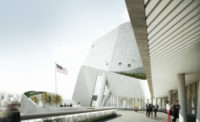Exhibition Review: Ten Tops at the Skyscraper Museum




















Twentieth-century New York showed the world that skyscrapers can be more than just tall buildings. Now Manhattan’s dazzling crowns are inspiring a "worldwide surge of signature tops,” says Carol Willis, the director of Manhattan’s Skyscraper Museum and an expert on buildings of 100 stories or more. Indeed, with more than a dozen such “supertalls” rising in Asia and the Middle East, the sky is getting quite a few new baubles.
Will any of them be as exciting as the pinnacles of the Chrysler and Empire State Building? The intriguing exhibition Ten Tops, at the Skyscraper Museum (through August), includes all manner of skyscraper pinnacles meant to dazzle, both from a distance and up close, where tourists crowd their atriums and observation decks. C.Y. Lee and Partners, designers of Taipei 101, which had a seven-year reign as the world’s tallest building, turned the tower’s “tuned mass damper,” a giant weight used to keep it from swaying uncomfortably in heavy winds, into an attraction. This damper is a 660-ton, gold-painted sphere hung from eight steel cables. It can move as much as five feet in high winds. Visitors find the ball transfixing.
By contrast, the highlight of the Shanghai World Financial Center isn’t a mass but a void—a giant cutout that was initially meant to be round, suggesting the moon gate of a Chinese garden. Unfortunately, Chinese officials instead saw Japan’s Rising Sun, and architect Bill Pedersen of Kohn Pedersen Fox had to replace the circle with a square.
One of the most fascinating sections of the show depicts the Makkah Royal Clock Tower, which sits atop (and was a separate commission from) the vast Abraj Al Bait hotel complex in Mecca. Non-Muslims will never see the building in person; in fact they weren’t allowed on the building site, which is why one engineer at Germany’s SL Rasch said he felt like he had missed the birth of his own baby. A fact-filled video describes the challenges of building a clock tower with four faces more than 150 feet in diameter and covered in 98 million glass tiles. But the mutant Big Ben is itself only a pedestal; it supports a 300-foot-high spire culminating in a 75-foot-long crescent of gold-covered fiberglass, large enough to contain a prayer room for the Saudi royal family. At 1,900 feet, it may be the highest occupied built space.
The Skyscraper Museum, at the foot of a mere 38-story building in Battery Park City, is just a stone’s throw from one of the least memorable tops in skyscraper history, the flat roof of Skidmore, Owings and Merrill’s (SOM) new One World Trade Center. A separate section of the museum, devoted to Ground Zero before and after 9/11, reveals what the building might have looked like had Daniel Libeskind’s original vision been realized. Instead, even the modest “antenna wrapper” proposed by Libeskind’s successor, David Childs of SOM, was value-engineered away, leaving a bare pole as the building’s anti-climax.
But it’s just as well because, this way, SOM’s rook poses no threat to Manhattan’s undisputed king and queen. For when it comes to supertall buildings with attention-getting tops, location matters. Towers in Taipei, Mecca, and Seoul have a chance to dominate skylines. But in established cities like New York, London, and Paris, Cracker Jack boxes with prizes on top only serve to disrupt established hierarchies, and rarely for the better.













